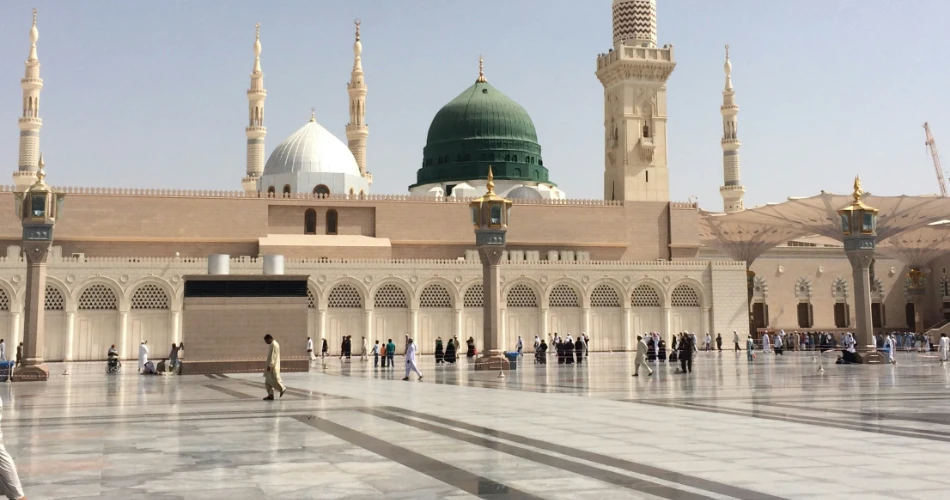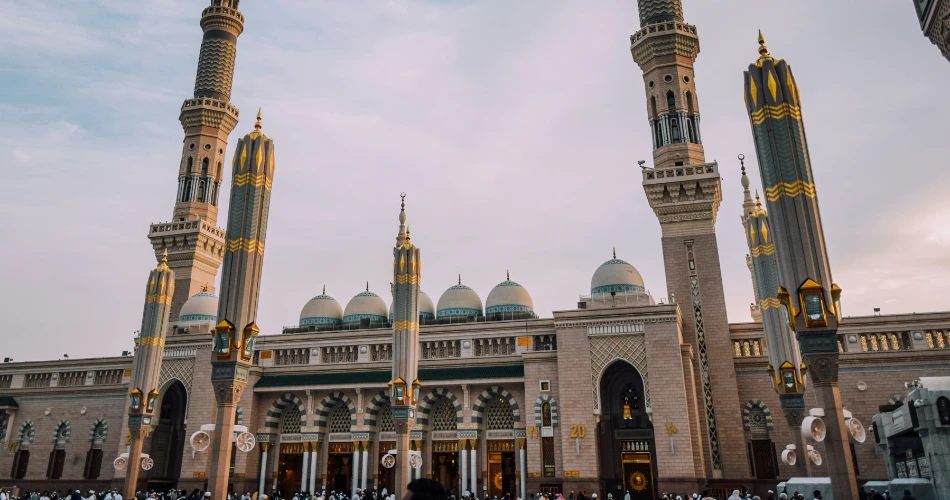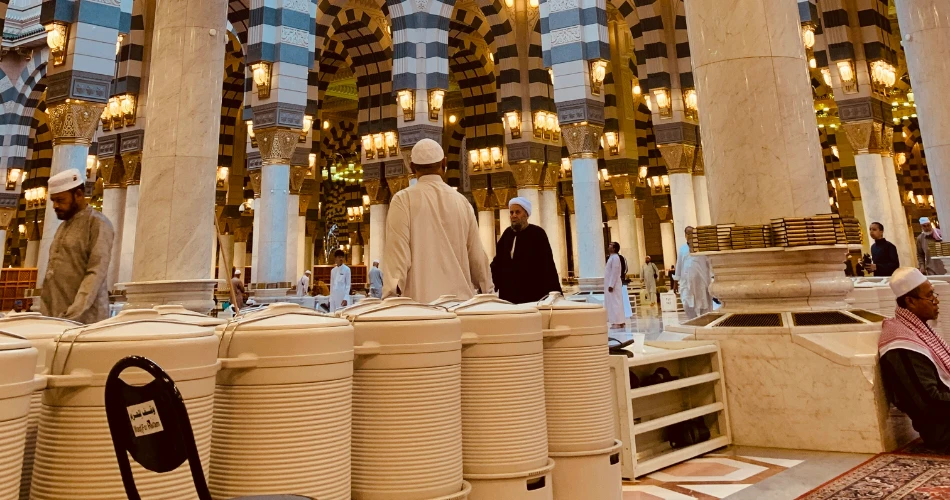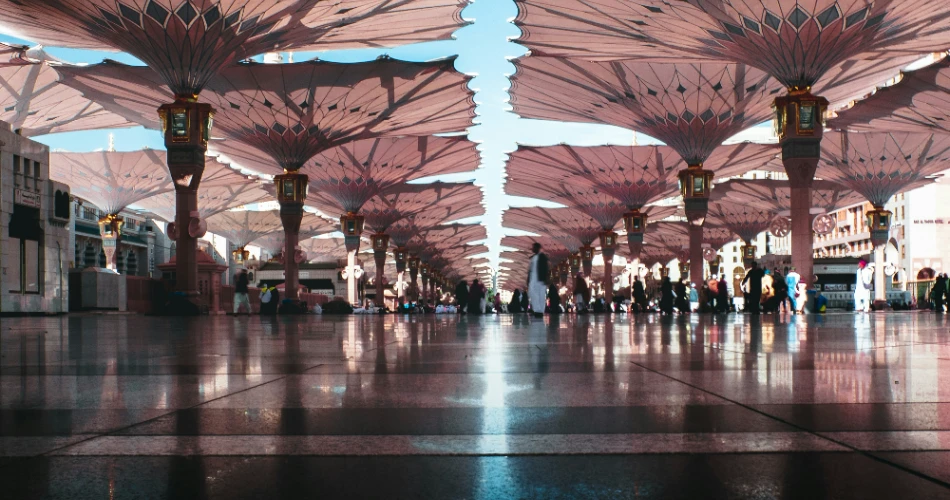Experiencing 42 Gates of Masjid e Nabavi: A Comprehensive Guide
Masjid e Nabwai: Overview on History

Masjid e Nabawi, located in Medina was founded by Prophet Muhammad (PBUH) and is the second-holiest place for Muslims after the Kaaba in Mecca. When the Prophet PBUH and his companions made Hijrah (migration) to Medina in the early years of Islam that is where it all began. Situated in the center of the city, the mosque was used as a place of worship, community center, court, and social hub. It now contains a number of the Prophet and his companions' possessions. Over the years Masjid e Nabawi has served as a location to spread Prophet PBUH teachings and discourses throughout the history of Islam. Furthermore, the neighboring Quba Mosque, which was the very first mosque built by Prophet PBUH, fed and housed the earliest Muslims, and also played an important role in making ties among early Islamic society.
The Gates Of Masjid E Nabawi: Gateways To Serenity

The 42 gates of Masjid al-Nabawi provide a majestic entryway to this beautiful holy mosque. These doors invite travelers to enter with respect and faith, serving as the starting point for a symbolic journey. They act as a reminder of the enduring relationship between religion, devotion, and the history of Prophet Muhammad (PBUH). Let's learn in detail all you need to know about the gates of Masjid e Nabawi.
-
Baab-As-Salaam (1st Gate)
Bab al-Salam, which translates to the "Gate of Peace," is the first gate that pilgrims encounter upon entering the Masjid al-Nabawi. Built by Umar ibn al-Khattab (R.A.) in the year 18 Hijri, it is located on the western wall of the mosque. While it is no longer in its original position, Bab al-Salam remains one of the first gates visitors pass through when entering to pay their respects at the Prophet Muhammad’s (PBUH) blessed resting place.
-
Abu Bakr Siddique Gate (2nd Gate)
Bab al-Abu Bakr al-Siddiq is the second gate of the Masjid al-Nabawi, named during the mosque's first renovation. Originally a smaller gate, it was later relocated to the western side of the mosque during subsequent expansions.
-
Bab-Ur-Rahman Gate (3rd Gate)
Bab-Ur-Rahman gate was originally constructed by Prophet Muhamad PBUH, and it was replaced towards the western side from its original spot. This door is also recognized as Bab e Atiqa Gate and is near 2A, as well as 2B parking.
-
Hijrah Gate (4th Gate)
Situated on the west side of Masjid al-Nabawi, the Hijrah Gate is characterized by its double-arched structure. This gate was named to commemorate Prophet Muhammad's (PBUH) Hijrah. Initially, it had only two openings, but during later renovations, two additional portals were added, making a total of four. Upon entering through this gate, visitors can view the renowned Hijri Clock, which strikes precisely at 12. The nearest underground car parks are 2A and 2B.
-
Quba Gate (5th Gate)
Situated towards Quba Village to the south of Masjid e Nabawi, the Quba Gate features a three-arched design. The King Fahad Block is located nearby. The nearest underground parking areas are 3A and 3B.
-
Gate 6: Masjid e Nabawi (6th Gate)
Pilgrims visiting the Mosque can take an elevator to the roof of Masjid e Nabavi from this gate and the closest parking lot is 4A, 4B, 5A, and 5B.
-
Gate King Saud (7th, 8th, and 9th Gate)
Named after King Saud bin Abdulaziz, who initiated the first expansion of Masjid al-Nabawi, the King Saud Gate is located on the southwestern side of the mosque. It is accessible to pilgrims and is notable for being near one of the tallest minarets among the six. The nearest parking areas to this gate are 6A and 6B.
-
Gate Imam Bukhari (Gate 10)
Gate 10, also known as the Imam Bukhari Gate, is situated on the western side of Masjid al-Nabawi, positioned between the King Abdul-Majid Gate and the King Saud Gate. The nearest parking areas to this gate are 6A and 6B.
-
Aqiq Gate (Gate 11)
Located on the western side of Masjid e Nabawi, the Aqiq Gate is named after Medina's Wadi al-Aqeeq, a valley where several of the Prophet’s companions resided. The nearest car parks is 7A and 7B.
-
Gate Sultan Abdul Majeed (12th, 13th, and 14th Gate)
Located on the northwestern side of the Malik Fahad extension, this gate features two large portals, five smaller ones, and a minaret. It is named after the late Sultan Abdul Majeed of the Ottoman Empire. The nearest parking areas are 7A and 7B.
-
Bab Umar Ibne al Khattab (16th 17th and 18th Gate)
Located near the main complex, this gate opens up in a library by the northern wall. It was named after Caliph Umar bin Khattab and features 18 portals in total. Moreover. The nearest car park is 8A, as well as 8B.
-
Badr Gate (Gate 19)
The Badr Gate, located on the mosque's northern side, features a marble engraving of a verse from Surah al-Hijr (15:46) that says, “Enter within in peace (be safe and secure).” The nearest underground parking is 9A and 9B.
-
King Fahad Gate (20th, 21st, and 22nd Gate)
Named after King Fahad bin Abdulaziz al-Saud, the King Fahad Gate is the primary entrance from the northern side of Masjid e Nabawi. This gate features five domes, seven doorways, and two minarets. The nearest parking areas are 10A and 10B.
-
Ohad Gate (Gate 23)
Gate 23 got its name from the famous Ohud Valley where the battle of Ohud was held. It is located by the foot of this valley and is among the smaller gates present at Masjid e Nabawi. The nearest parking grounds are 10A, as well as 10B.
-
Usman bin Affan Gate (24th 25th and 26th Gate)
This gate is named after the third caliph, Usman ibn Affan. It is one of the largest gates of Masjid e Nabawi and is located near underground parking 11A and 11B. Women can enter this from here to access the Riaz ul Jannah gate.
-
Gate Ali Ibne Abi-Talib (28th 29th and 30th Gate)
Named after the cousin and son-in-law of Prophet Muhammad PBUH, one of Masjid e Nabawi's biggest entrances is Ali ibn e Abi Talib gate. It is located over the Eastern wall of the mosque near the underground parking 12, as well as 13.
-
Abuzar Ghafari Gate (31st and 32nd Gate)
Hazrat Abuzar Ghafari was the closest companion of Prophet PBUH and the fifth individual to accept Islam. It is nestled between Bab e Ali and Bab e Abdul Aziz. The underground car park 12, as well as 13, is closest to this gate.
-
Gate Abdul Aziz (33rd 34th and 35th gate)
Featuring two large portals, five smaller ones, and a minaret, the Abdul Aziz Gate is one of the largest gates of Masjid e Nabawi. The nearest parking areas are 12A and 13A.
-
Masjid e Nabawi’s Gate 36
Although this gate does not have any official name, it gives access to the burial ground of Prophet Muhammad PBUH. It has elevator access which takes pilgrims to the rooftop.
-
Makkah Gate (37th Gate)
Also known as the Gate of Makkah, this gate is located on the southern wall of the Malik Fahad extension and faces toward Makkah. It follows the architectural patterns of the original gate. The nearest underground parking is 1A and 1B.
-
· Bilal Gate (38th Gate)
The very first Islam muezzin, Bilal ibn Habashi, is honored with gate number 38, one of four portal entrance points on the south side of the King Fahad Complex. People visiting Riyaz-ul-Jannah must make a line in front of this gate to enter. It is close to parking 1A, as well as 1B which are underground.
-
Bab un Nisa (39th Gate)
The Ladies Gate in Madinah was established during the caliphate of Umar ibn Khattab, allowing women to easily access and exit the mosque grounds. Initially open to all, its use was later restricted to women during the leadership of Umar bin Abdul Aziz. Today, however, it is primarily used by men and remains one of the gates closest to the grave of Prophet Muhammad (PBUH). The nearest underground parking areas are 2A and 2B.
-
Bab Jibrel (40th Gate)
The Angel Jibril entering the Prophet's PBUH residence is symbolized by this gate, also called the Bab e Nabi. It is known that his gate was shifted eastwards according to the time of the expansion of Masjid e Nabawi. Underground parking 2A and 2 B are the nearest parking spots.
-
Bab ul Baqi (41st Gate)
Gate 41 is the closest gate to Prophet's PBUH's last resting place and features two Arabic inscriptions and one minaret. The closest car park to this gate is 2A, as well as 2B.
-
Aiymah Gate (42nd Gate)
At last, we have Aiymah Gat also known as “The Gate of Imams”. It is the smallest gate in Masjid e Nabawi and provides access to the Rawdah-e-Rasool. This gate is mostly used by imams of the masjid and is near Mehrab e Usmani. This gate is closest to parking 2A and 2B which are located underground.
The Architectural Beauty of Masjid E Nabawi Gates

Masjid Al Nabawi's detailed and beautiful architecture reflects the mosque's rich history of evolution, adding a spark to its view apart from its religious value. The mosque's gates, which are more than just entrances, are an essential part of this architecture and contribute significantly to its beauty. The recent Saudi extensions and renovations of the Mosque have significantly increased the pilgrimage capacity. That’s why, the historical significance, spirituality, and magnificence of Masjid Al Nabawi's forty-two gates must be acknowledged properly to appreciate it.
The Gates as Historical Witnesses and Their Symbolism

These magnificent gates of Masjid Al Nabawi have subtly but profoundly influenced the mosque's history in many ways. Apart from being just an entrance, each gate symbolizes a distinctive design that reflects the sociopolitical environment and architectural tastes of the relevant time. These gates also show symbols of power, cultural identity, and spiritual value. The gates featured recognizable Ottoman architecture from the Ottoman era, highlighting the dedication and devotion of Muslim rulers across the seas. In the initial days when the Prophet Muhammad (PBUH) and his companions migrated to Medina, the mosque was first used as a place of worship, a community hub, and a court. It still serves as a location for religious instruction and sermons and now holds the possessions of the Prophet and his closest companions.
Find the top hotels near Masjid al-Nabawi at Medinahotels.co for a comfortable and convenient stay.



